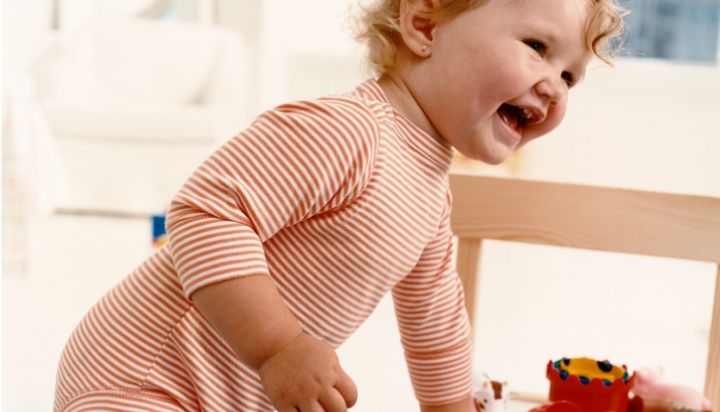SIGNS YOUR CHILD IS READY FOR POTTY TRAINING
Short Answer: When He or She "Knows" Its Time To Go.
It may sound a bit funny, but your child is generally ready if he or she knows “somethings going on down there” when something is in fact “going on down there.” By this we mean that your child is almost certainly ready if he or she is running to the corner or somewhere else to go to the bathroom (this indicates they are aware of the bodily signals associated with going to the bathroom and equating this with privacy). Another CLEAR sign he or she "knows," is a child coming to find you for diaper changes.
If there is ONE KEY TAKEAWAY for parents, it's that rarely is a child over 22 months “not ready” for potty training. In fact, children are usually ready much earlier—often between 18 months and 20 months.
While we think a child who "knows" is a great proxy for a child who is ready, some programs break things down into different types of "readiness." At One Proud Toddler, we focus on three:
1) Bodily Readiness - Your child can hold urine for an hour or two (i.e. you are seeing diapers stay dry this long), knows when or she has to poop/pee and has the necessary motor skills (i.e. can walk to and sit on the training potty).
2) Cognitive Readiness - Your child can communicate needs (throwing tantrums counts), respond to basic instructions (i.e. "say ABC") and shows some interest/understanding of what the potty is for.
3) Psychological Readiness - Your child is at the age when he or she wants to please you just because you are mom or dad (this almost always starts occurring around 20 months).
Don't let all of this confuse or worry you. If you think you child is ready to train, he or she almost certainly is. Rarely is a child over 22 months “not ready” for potty training. In fact, children are usually ready much earlier—often between 18 months and 20 months.
As detailed on our blog Why Early Potty Training Is Better Potty Training—and dovetailing with the concept of Psychological Readiness identified above—there is a zone between 20 and 30 months when children are behaviorally “primed” to potty train. In short, if your child is in this age range and you suspect he or she is ready to train, then this is almost certainly the case.
Getting A Leg Up

Between 12-And-20 Months
Just like learning any new task, it helps tremendously if you some general familiarity with what needs to be done before you being. In the case of potty training, you can start “priming” your child for success as early as 12 months, and definitely by 18-to-20 months. An added benefit of taking these steps early is that they will familiarize your child with the toilet and bathroom, removing much of the "scare" factor.
HELPFUL STEPS TO TAKE BETWEEN 12-AND-20 MONTHS
- Bring your child to the restroom with you and explain what you are doing (e.g. “Mommy is going pee pee”)
- Choose your "potty words" and stick to them (e.g. teach your child to say “poo poo” and “pee pee” when he or she is, you know, going poo or pee).
- Teach your child to say a funny word like "bangaboong" when he or she farts (your child may even begin farting on command, which is a huge sign he or she is ready to train).
- Point out when his siblings or the dog are going to the bathroom.
- Don't make going to the bathroom "yucky" or "gross."
- Teach you child to come to you whenever he or she has a dirty diaper.
At Around 20 Months (Or Just Before You Start Training)
So your child is just entering or already has entered the "zone" when he or she is psychologically primed to potty train (i.e. between 20-and-30 months) and you are on the cusp of pulling the trigger.
If you haven't taken any of the steps listed above, then the time to start is NOW! If you have, then good job! Regardless, taking these last minute actions can pay tremendous dividends:
HELPFUL STEPS TO TAKE AT 20 MONTHS OR JUST BEFORE TRAINING
- Introduce your child to the toilet and explain how it is used.
- Start changing your child's diapers in the bathroom at home and have him or her watch while you flush the contents of poop diapers down the toilet.
- Buy a set of underwear with your child and explain what they are and that he or she will be using those instead of diapers soon.
- Read potty training books together with your child.
Our Call To Arms!
At One Proud Toddler (if you couldn’t already tell) we are adherents to the early is better approach. While “child led” training has a nice ring to it, the fact is that adults are responsible for teaching children how to properly behave in this world, which includes using the toilet.
In short, we don't allow toddlers to make their own major life choices in other realms and potty training, as one of your child’s first major life learning exercises, is no exception!
More Interesting Reads

Making Sense of different potty training methods: A Framework for understanding
Potty training looks complicated, but the truth is all the methods out there can be broken down into six easy-to-understand categories. Let us help make sense of the madness.

The Potty Proud Approach: A Step-by-step guide to potty Train your child fast!
Read our step-by-step approach to teaching your child the foundations of potty training in three days.

Why Early Potty Training is Better Potty Training
There are a TON of reasons to start potty training early rather than later. Find out the science behind why early is better.
